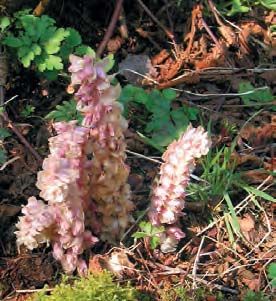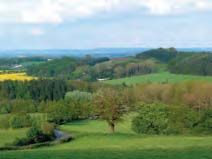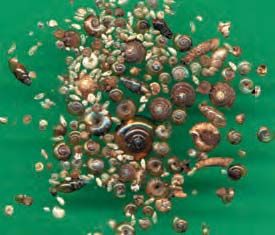|
‘The main block of the Wyre Forest in Worcestershire is on relatively acid soils, but there are small outcrops of limestone on the edges of the area which are often difficult to find but could support a greater range of mollusc species. It was with this in mind that we arranged a meeting to two woodland sites immediately south of the forest. The meeting was led by Rosemary Winnall of the Wyre Forest Visitor Centre, who has invaluable local knowledge. From the Visitor Centre we travelled to Areley Wood at SO 791711. The wood is accessed from the very narrow and winding B 4194 Ribbesford Road from which there is a right of way into the wood. Areley Wood consists of mixed deciduous woodland. Most of it is oak/hazel coppice on Silurian red sandstone, but there are ash trees in places and the sandstone occasionally contains bands of Spirorbis limestone which are rather hard to find. Some of the plant species present, which include Paris quadrifolia, are indicators of ancient woodland, but there are signs of former mining activity in the wood so this is not a completely undisturbed site. There were a number of clumps of the parasitic plant Lathraea squamaria in flower when we visited. A general search of the area yielded the following species: Discus rotundatus, Arion ater agg., Arion subfuscus, Arion distinctus, Arion intermedius, Vitrina pellucida [shells], Aegopinella nitidula, Oxychilus cellarius, Oxychilus alliarius, Oxychilus helveticus, Limax maximus, Deroceras reticulatum, Cochlodina laminata, Clausilia bidentata, Trichia striolata, Arianta arbustorum, Cepaea nemoralis and Cepaea hortensis. Leaf litter collected from a patch of Chrysosplenium oppositifolium near a stream additionally yielded shells of Acicula fusca and live Carychium tridentatum, Cochlicopa lubrica, Cochlicopa lubricella, Acanthinula aculeata, Vitrina pellucida, Vitrea crystallina, Nesovitrea hammonis, Aegopinella pura and Euconulus fulvus. Acicula fusca is not common in the Midlands and it would be worth while to do more sampling at this site to see if it could be found alive. As with any wood where there may be pockets of more calcareous substrata, more detailed sampling could yield more species. In the afternoon we went further south to Abberley Hill woods at SO 769681. The woods have several rights of way across them including the Worcestershire Way and are situated on a rather narrow plateau on top of an extremely steep hill and form a noted landmark with splendid views over the area. The vegetation is of ash and sycamore on fossiliferous Silurian limestone containing the remains of trilobites and other creatures. The early purple orchid Orchis mascula is abundant here. We only had time to survey Shaver’s End, the northernmost part of the wood. Mollusc species encountered were Cochlicopa lubrica, Cochlicopa lubricella. Lauria cylindracea, Ena obscura, Discus rotundatus, Arion ater agg., Arion subfuscus, Arion circumscriptus seg., Arion distinctus, Vitrina pellucida, Vitrea crystallina, Vitrea contracta, Nesovitrea hammonis, Aegopinella nitidula, Oxychilus cellarius, Oxychilus alliarius, Oxychilus helveticus, Limax maximus, Cochlodina laminata, Clausilia bidentata, Monacha cantiana, Trichia hispida, Cepaea nemoralis and Cepaea hortensis. Rosemary Hill and myself made a further visit to these woods on 1 May 2005. A scree slope near SO 768679 yielded Lauria cylindracea, Discus rotundatus, Arion subfuscus, Arion circumscriptus seg., Arion hortensis seg., Aegopinella nitidula, Oxychilus alliarius, Limax maximus, Cochlodina laminata and Clausilia bidentata. Further up the hill on the Worcestershire Way at SO 768674 we found shells of Vitrina pellucida and live examples of Discus rotundatus, Arion ater agg., Arion intermedius, Aegopinella nitidula, Limax marginatus, Deroceras reticulatum and Cepaea nemoralis. Much more remains to be done at such a large site, particularly in the damper areas at the base of the hill and below the quarry. The southern end of the wood nearest Great Witley has not yet been looked at. Our thanks are due to the owner of Areley Wood Mr Reynolds-Lacey for kind permission to investigate this site.’ |
1. Toothwort Lathraea squamaria in Areley wood on 2 April 2005. (Photo: Rosemary Hill)
2. View from Abberley hill on 1 May 2005. (Photo: Ron Boyce)
3. Shells in leaf litter sample from Areley wood on 2 April 2005. (Photo: Ron Boyce)
4. Rock with Silurian fossils on Abberley hill on 2 April 2005. (Photo: Rosemary Hill)
|
Field meeting to Wyre Forest outliers, 2 April 2005
Issue
9
Page
5




